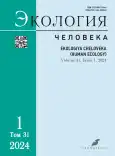基于 Lee-Carter 模型的特定年龄死亡率建模和预测
- 作者: Borschuk E.L.1, Begun D.N.1, Bolodurina I.P.1,2, Menshikova L.I.3, Kolesnik S.V.2, Duisembaeva A.N.2
-
隶属关系:
- Orenburg State Medical University
- Orenburg State University
- Northern State Medical University
- 期: 卷 31, 编号 1 (2024)
- 页面: 61-76
- 栏目: ORIGINAL STUDY ARTICLES
- URL: https://journal-vniispk.ru/1728-0869/article/view/264853
- DOI: https://doi.org/10.17816/humeco611099
- ID: 264853
如何引用文章
全文:
详细
论证。人口死亡率高问题仍然是俄罗斯最重要的公共卫生问题之一。国家政策的优先任务之一是降低劳动年龄人口的死亡率,延长预期寿命。预测人口死亡率是合理分配各类资源的工具。
目标。 基于Lee-Carter模型的奥伦堡地区死亡率建模和预测。
材料与方法。研究了1991-2020年奥伦堡地区的年龄和性别死亡率以及总人口。 使用Lee-Carter方法对人口死亡率进行建模和预测。 根据计算得到的参数,构建了带漂移的随机游走模型,并进行了精度评定。
结果。对于奥伦堡地区,Lee-Carter模型描述了男性人口的死亡率。 通过对奥伦堡地区男性人口死亡率的建模,获得了87%的拟合精度,足以评估长期预测的结果,并构建了到2035年的死亡率预测。
结论。对所得结果的分析表明,大流行病对人口死亡率的影响是短期的,在未来几年中,奥伦堡州男性人口的死亡率将继续下降。
作者简介
Evgenii Borschuk
Orenburg State Medical University
Email: be@nm.ru
ORCID iD: 0000-0002-3617-5908
PhD, Professor, Head of the Department of Public Health and Healthcare No. 1
俄罗斯联邦, 7 Park Ave., Orenburg, 460000Dmitrii Begun
Orenburg State Medical University
Email: be@nm.ru
ORCID iD: 0000-0002-8920-6675
SPIN 代码: 8443-4400
MD, Dr. Sci. (Medicine), Professor of the Department of Public Health and Healthcare No. 1
俄罗斯联邦, 7 Park Ave., Orenburg, 460000Irina Bolodurina
Orenburg State Medical University; Orenburg State University
Email: prmat@mail.osu.ru
ORCID iD: 0000-0003-0096-2587
SPIN 代码: 4848-0669
Dr. Sci. (Engineering), Professor
俄罗斯联邦, 7 Park Ave., Orenburg, 460000; OrenburgLarisa Menshikova
Northern State Medical University
Email: menshikova1807@gmail.com
ORCID iD: 0000-0002-1525-2003
SPIN 代码: 9700-6736
MD, Dr. Sci. (Med.), Professor
俄罗斯联邦, ArkhangelskSvetlana Kolesnik
Orenburg State University
Email: svkolesnik_osu@mail.ru
ORCID iD: 0009-0009-3008-0308
SPIN 代码: 7548-3688
俄罗斯联邦, Orenburg
Aislu Duisembaeva
Orenburg State University
编辑信件的主要联系方式.
Email: k.kro1@yandex.ru
ORCID iD: 0000-0001-5762-4277
SPIN 代码: 7164-7107
Scopus 作者 ID: 58149835100
俄罗斯联邦, Orenburg
参考
- Zemlyanova EV. Attitude of population and experts to the measures for reduction of mortality in Russia (literature review). Social Aspects of Population Health. 2013;(3):3. EDN: QINGER
- Bolotova EV, Samorodskaya IV, Dudnikova AV. The structure of mortality and potential years life lost from respiratory diseases of the population of economically active age (15–72 years) of the Russian Federation in 2019. Vrach (The Doctor). 2021;32(11):5–10. EDN: EHMGSS doi: 10.29296/25877305-2021-11-01
- Kozlova OA, Makarova MN, Tukhtarova EH, Belenkova TV. The labour conditions as a factor of the working age population mortality. Fundamental Research. 2015;(7-1):161–165. EDN: UDXTXB
- Nizamov IG, Sadykova TI. Health of economically active population as a basis of social-and-economical development of Russia and its regions. Public Health and Health Care. 2012;(4):28–33. EDN: PMSMIT
- Rodionova LA, Kopnova ED. Statistical approaches to analysis and modeling of seasonality in demographic data. Demographic Review. 2019;6(2):104–141. EDN: FJVXKS
- Denisenko MB, Varshavskaya EYa. Working life expectancy in Russia. Higher School of Economics Economic Journal. 2017;21(4):592–622. EDN: YLBIWS
- Ivanova AE, Kondrakova EV. Grounds for life expectancy projections in Russian regions up to 2025. Social Aspects of Population Health. 2008;(1):8. EDN: JVWSNB
- Lazarev AV, Kalininskaya AA, Vasilieva TP. Organizational reserves saving the population's health from diseases of the circulatory system. Problems of Social Hygiene, Public Health and History of Medicine. 2020;28(S):762–765. EDN: DGCWUU doi: 10.32687/0869-866X-2020-28-s1-762-765
- Temeshova NV. Implementation of the concept of demographic policy of the Russian Federation for the period till 2025 in 2016–2020. In: State and municipal administration in the Kamchatka territory: problems and solutions. Petropavlovsk-Kamchatsky; 2018. P. 70–78. EDN: YTTQTJ
- Soyan ShCh. Life expectancy as an indicator of the quality of life of the population. Natural Resources, Environment and Society. 2021;(3):42–46. EDN: KXIIUS doi: 10.24412/2658-4441-2021-3-42-46
- Lakman IA, Askarov RA, Prudnikov VB, et al. Predicting mortality by causes in the Republic of Bashkortostan using the Lee–Carter model. Problemy Prognozirovaniya. 2021;(5):124–138. EDN: ISEHRS doi: 10.47711/0868-6351-188-124-138
- Booth H. Demographic forecasting: 1980 to 2005 in review. International Journal of Forecasting, 2006;22(3):547–581. doi: 10.1016/j.ijforecast.2006.04.001
- Cancho-Candela R, Llano JMA, Ardura-Fernández J. Decline and loss of birth seasonality in Spain: analysis of 33,421,731 births over 60 years. Journal of Epidemiology & Community Health. 2007;61(8):713–718. doi: 10.1136/jech.2006.050211
- Lee RD, Carter LR. Modeling and forecasting U.S. mortality. Journal of the American Statistical Association. 1992;87(419):659–671. doi: 10.1080/01621459.1992.10475265
- Haberman S, Russolillo M. Lee–Carter mortality forecasting: application to the Italian population. 2005. Actuarial Research Paper No. 167.
- Khubaev G. Regression models for forecasting life period of population of administrative-territorial education: construction and evaluation of quality. Bulletin of Science and Practice. 2018;4(9):206–217. EDN: XZBZZR doi: 10.5281/zenodo.1418761
- Supraniuk SB, Toprak S. Forecast of mortality from cardiovascular and cerebrovascular diseases of working-age residents of the region. In: Current Issues of Scientific Knowledge. Kurgan; 2020, P. 255–261. EDN: DHZBVD
- Edeleva AN, Starodubov VI, Fedotkin MA, et al. Mathematical modeling in performance management of medical organizations providing inpatient care to the elderly. Social Aspects of Population Health. 2018;(2):2. EDN: XUFBWH
- Buleshov MA, Alipbekova SN, Tuktibayeva SA. Modern medical and social aspects of morbidity and mortality rates in the working age population. Bulletin of the Kazakh National Medical University. 2021;(1):285–288. EDN: TJDVBJ
- Zaitseva NV, Kiryanov DA, Kamaltdinov MR, et al. Health risks analysis and complex procedure for estimating the effectiveness of targeted activities performed within regional public healthcare systems and aimed at reducing mortality among the population caused by cardiovascular diseases and oncological diseases. Health Care of the Russian Federation. 2021;65(4):302–309. EDN: DVUUDG doi: 10.47470/0044-197X-2021-65-4-302-309
- Cerda-Hern'andez J, Sikov A. Lee-Carter method for forecasting mortality for Peruvian Population. 2018. Papers 1811.09622, arXiv.org.
- Belliard M, Williams I. Proyección estocástica de la mortalidad. Una aplicación de Lee-Carter en la Argentina. Revista Latinoamericana de Población. 2013;7(13):129–148.
补充文件














